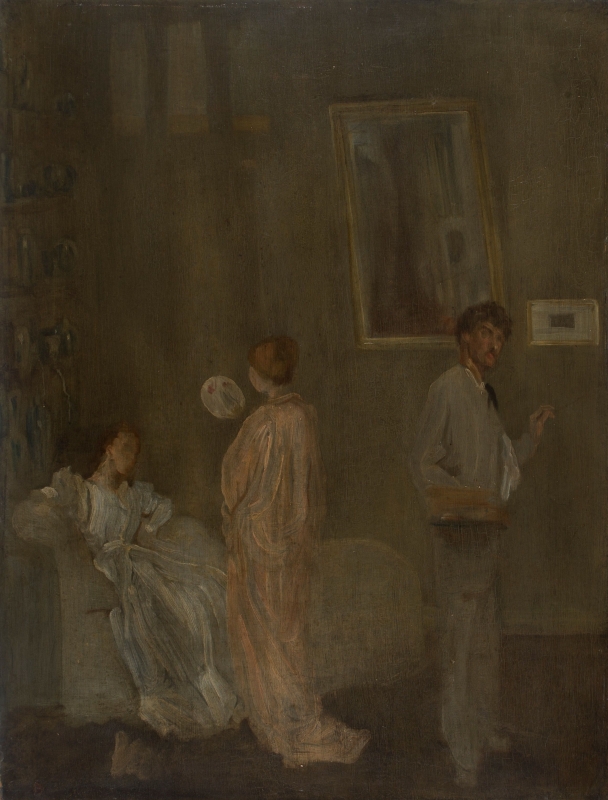Home > Catalogue > Browse > The Artist's Studio << >>
Titles
One main title has been suggested:
Description
An interior scene in vertical format, showing the corner of a studio. The artist stands at right, looking at the viewer, holding a brush and palette and in the act of painting, though the easel and canvas are out of the picture to right. He wears a pale grey jacket, white shirt, short black cravat, and darker grey trousers. At left is a white sofa with a young woman in a white dress seated looking up at another woman. The standing woman is dressed in a pale pink-flesh-coloured robe that trails behind her. She holds a white fan up in front of her face, and is turning away from the viewer. Behind the sofa at left are four shelves of blue and white porcelain. High on the wall at upper left, just to right of the shelves, are three narrow picture frames or hanging scrolls. Behind Whistler is a large mirror, slightly tilted forward at the top and streakily reflecting the room; to its right, just to right of the artist's head, is a small framed picture or print. The walls are grey, the floor a light brown. The picture is rather dark.
Site
The same scene is shown in The Artist in his Studio (Whistler in his Studio) [YMSM 063], which, according to Whistler's biographers, the Pennells, was painted 'in the first house in Lindsey Row' (7 Lindsey Row, Chelsea, London). 3
The photograph reproduced above shows porcelain arranged on the wall in the Lindsey Row house. 4
Sitter
James McNeill Whistler (1834-1903) and two models: the woman on the sofa was Joanna Hiffernan (b. ca 1843-d.1886). The standing woman was described by Whistler as the 'Japonaise'. 5 She may have been Emelie 'Millie' Eyre Jones (1850-1920), who also posed for Symphony in White, No. 3 [YMSM 061] in a similar setting, sitting on the floor by the studio sofa. 6 Sittings for the two paintings, and indeed for a third, The Artist in his Studio (Whistler in his Studio) [YMSM 063], may have overlapped.
This is partially confirmed by Mary Glenn Perine (1822-1896) , who visited Whistler's mother at 2 Lindsey Row and described seeing a model, the wife of an 'Ethiopian minstrel', posing for Whistler in Chinese drapery. 7 Emelie Eyr Jones was married to Frederick Henry Robson, an actor or 'black and white minstrel', and may have been posing for The Artist in his Studio (Whistler in his Studio) or The Artist's Studio at the time of Mrs Perine's memoir.
Comments
The Dublin City Gallery website comments:
'Whistler earned a significant portion of his income through portrait commissions and he maintained an elegant studio where his sitters could pose. This setting is evoked in this work but not in a literal manner ... on the left is his collection of blue and white porcelain. The Japanese costume, fan and graceful posture of the standing woman attest to Whistler’s interest in Asian art; this model converses with Hiffernan who sits in a casual pose. In this work, Whistler subtly displays his creative concerns and comments on his self-image as an artist who is inspired by muses of his own choosing. There is a sense of immediacy and spontaneity to this intimate scene in the thin, gestural application of paint. Originally, he intended to make a monumental, ten-foot-high painting that would, in size and subject, refer to Diego Velázquez’s famous studio scene, Las Meninas (1656; Madrid, Museo del Prado), the Spanish artist’s controversial exploration of artistic identity, but never realised his ambition. Whistler appears less confident in this painting than in many other self-portraits and seems to define himself less by his likeness than by the objects of beauty with which he has surrounded himself ... one cannot see what he is painting; it is almost as if it is the viewer he has taken as his subject, as he peers straight out of the canvas as if at a sitter.' 8
Notes:
1: Pictures presented to the City of Dublin to form the Nucleus of a Gallery of Modern Art, also pictures lent by the executors of the late James Staats Forbes and others, Royal Hibernian Academy, Dublin, 1904 (cat. no. 77).
2: YMSM 1980 [more] (cat. no. 62).
3: Pennell 1911 A [more], p. 129.
4: Pennell 1921C [more], repr. f.p. 153.
5: Whistler to Fantin-Latour, 16 August [1865], GUW #11477.
6: The Pennells considered that the models were the same woman who had posed for Symphony in White, No. III, namely Hiffernan and Jones: Pennell 1911 A [more], p. 129.
7: [20 July 1868], Diary, Maryland Historical Society Library, Manuscripts Division, Baltimore, MD.
8: Dublin City Gallery, website at http://emuseum.pointblank.ie/online_catalogue.
Last updated: 1st December 2020 by Margaret







